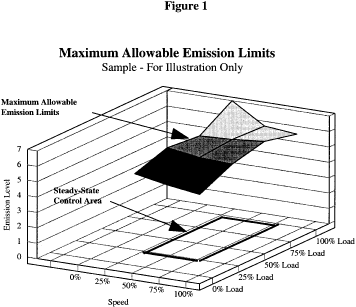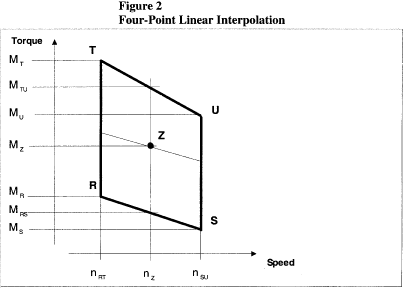Title 40
SECTION 86.1360
86.1360 Supplemental emission test; test cycle and procedures.
§ 86.1360 Supplemental emission test; test cycle and procedures.The test procedures of this subpart N apply for supplemental emission testing, except as specified otherwise in this section.
(a) Applicability. This section applies to 2007 and later diesel heavy duty engines.
(b) Test cycle. (1) Perform testing as described in § 86.1362 for determining whether an engine meets the applicable standards when measured over the supplemental emission test.
(2) For engines not certified to a NOX standard or FEL less than 1.5 g/bhp-hr, EPA may select, and require the manufacturer to conduct the test using, up to three discrete test points within the control area defined in paragraph (d) of this section. EPA will notify the manufacturer of these supplemental test points in writing in a timely manner before the test. Emission sampling for these discrete test modes must include all regulated pollutants except particulate matter.
(3) For engines certified using the ramped-modal cycle specified in § 86.1362, perform the three discrete test points described in paragraph (b)(2) of this section as follows:
(i) Allow the engine to idle as needed to complete equipment checks following the supplemental emission test described in this section, then operate the engine over the three additional discrete test points.
(ii) Validate the additional discrete test points as a composite test separate from the supplemental emission test, but in the same manner.
(iii) Use the emission data collected during the time interval from 35 to 5 seconds before the end of each mode (excluding transitions) to perform the MAEL calculations in paragraph (f) of this section.
(c) The engine speeds A, B and C, referenced in the table in paragraph (b)(1) of this section, must be determined as follows:
Speed A = nlo + 0.25 × (nhi − nlo) Speed B = nlo + 0.50 × (nhi − nlo) Speed C = nlo + 0.75 × (nhi − nlo) Where: nhi = High speed as determined by calculating 70% of the maximum power. The highest engine speed where this power value occurs on the power curve is defined as nhi. nlo = Low speed as determined by calculating 50% of the maximum power. The lowest engine speed where this power value occurs on the power curve is defined as nlo. Maximum power = the maximum observed power calculated according to the engine mapping procedures defined in 40 CFR 1065.510.(d) Determining the control area. The control area extends from the engine speed A to C, as defined in paragraph (c) of this section, and extends from 25 to 100 percent load.
(e) [Reserved]
(f) Maximum allowable emission limits. (1) For gaseous emissions, the 12 non-idle test point results and the four-point linear interpolation procedure specified in paragraph (g) of this section for intermediate conditions, shall define Maximum Allowable Emission Limits for purposes of § 86.007-11(a)(3) except as modified under paragraph (f)(3) of this section. Each engine shall have it's own Maximum Allowable Emission Limits generated from the 12 non-idle supplemental steady state test points from that engine. The control area extends from the 25% to the 75% engine speeds, at engine loads of 25% to 100%, as defined in paragraph (d) of this section. Figure 1 of this paragraph (f)(1) depicts a sample Maximum Allowable Emission Limit curve, for illustration purposes only, as follows:

(2) If the weighted average emissions, calculated according to paragraph (e)(6) of this section, for any gaseous pollutant is equal to or lower than required by § 86.007-11(a)(3), each of the 13 test values for that pollutant shall first be multiplied by the ratio of the applicable emission standard (under § 86.007-11(a)(3)) to the weighted average emissions value, and then by 1.10 for interpolation allowance, before determining the Maximum Allowable Emission Limits under paragraph (f)(1) of this section.
(3) If the Maximum Allowable Emission Limit for any point, as calculated under paragraphs (f)(1) and (2) of this section, is greater than the applicable Not-to-Exceed limit (if within the Not-to-Exceed control area defined in § 86.1370(b)), then the Maximum Allowable Emission Limit for that point shall be defined as the applicable Not-to-Exceed limit.
(g) Calculating intermediate test points. (1) For the three test points selected by EPA under paragraph (b)(2) of this section, the emissions must be measured and calculated as described in paragraph (e)(6)(i) of this section (except that n = 1 and WF = 1). The measured values then must be compared to the interpolated values according to paragraph (g)(3) of this section. The interpolated values are determined from the modes of the test cycle closest to the respective test point according to paragraph (g)(2) of this section.
(2) Interpolating emission values from the test cycle. The gaseous emissions for each regulated pollutant for each of the control points (Z) must be interpolated from the four closest modes of the test cycle that envelop the selected control point Z as shown in Figure 2 of this paragraph (g)(2).
(i) For these modes (R, S, T, U), the following definitions apply:
(A) Speed (R) = Speed(T) = nRT.
(B) Speed (S) = Speed(U) = nSU.
(C) Per cent load (R) = Per cent load (S).
(D) Per cent load (T) = Per cent load (U).
(ii) The interpolated value of the brake specific gaseous emissions of the selected control point Z(EZ) must be calculated as follows:
EZ = ERS + (ETU-ERS) * (MZ-MRS) / (MTU-MRS) ETU = ET + (EU-ET) * (nZ-nRT) / (nSU-nRT) ERS = ER + (ES-ER) * (nZ-nRT) / (nSU-nRT) MTU = MT + (MU-MT) * (nZ-nRT) / (nSU-nRT) MRS = MR + (MS-MR) * (nZ-nRT) / (nSU-nRT) Where: ER, ES, ET, EU = for each regulated pollutant, brake specific gaseous emissions of the enveloping modes adjusted according to the factors in(f)(2). MR, MS, MT, MU = engine torque of the enveloping modes. MZ = engine torque of the selected control point Z. nZ = engine speed of the selected control point Z.(iii) Figure 2 follows:

(3) Comparing calculated and interpolated emission values. The measured brake specific gaseous emissions of the control point Z (XZ) must be less than or equal to the interpolated value (EZ).
[65 FR 59958, Oct. 6, 2000, as amended at 66 FR 5188, Jan. 18, 2001; 70 FR 40439, July 13, 2005; 71 FR 51487, Aug. 30, 2006; 73 FR 37192, June 30, 2008. Redesignated and amended at 79 FR 23704, Apr. 28, 2014]